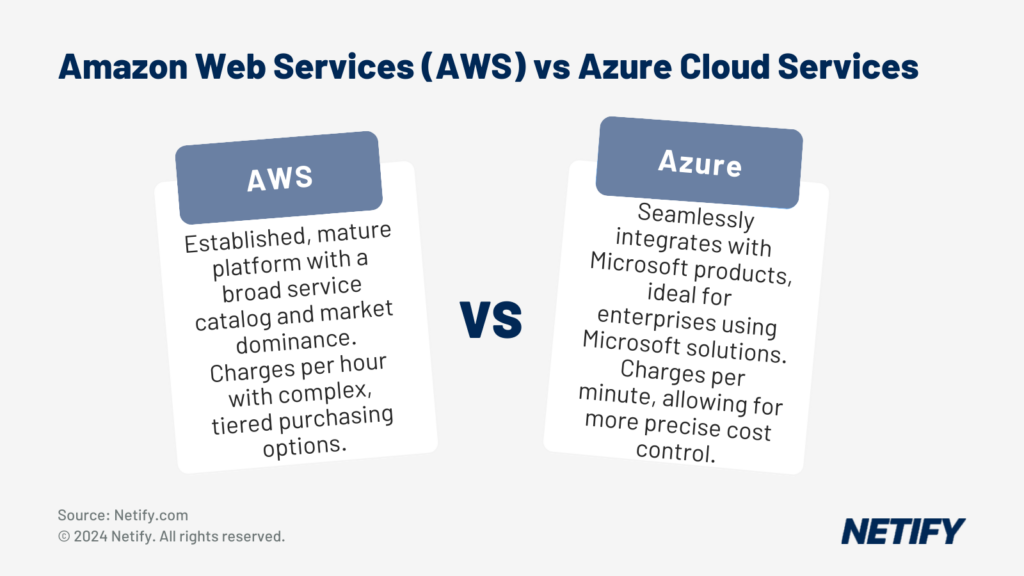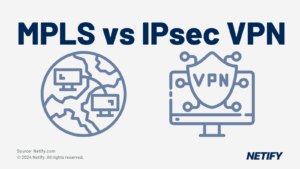Microsoft Azure integrates with other Microsoft products. AWS offers a wider range of services and more scalability. Choosing between Azure and AWS should depend on existing tools and specific business priorities. |

What is Microsoft Azure and Amazon AWS? Microsoft Azure is a cloud service platform by Microsoft. Formerly known as Windows Azure, it’s a popular platform with a range of cloud services from computing to analytics to networking and storage. Though many believe Microsoft predates Amazon, Amazon Web Services (AWS) actually came before Azure. AWS also leads the pack on cloud services, delivering an operating profit of $3.1 billion on revenue of $12.22 billion in 2016, with an annual operating profit margin of more than 25%.
What is Azure?
- Azure is viewed as both a Platform as a Service (PaaS) and an Infrastructure as a Service (IaaS) offering.
- Azure is a uniquely powerful offering because of its parent company. Few enterprises have a level of infrastructure support equal to Microsoft.
What is AWS?
- AWS, like Amazon itself, has a vast toolset that’s growing at an exponential rate.
- It’s been in the cloud computing market for more than 10 years, which means that AWS is the frontrunner and has been for some time.
- AWS services are categorised as Platform as a Service (PaaS), Infrastructure as a Service (IaaS) and Software as a Service (Saas).
Microsoft Azure vs Amazon AWS
On the surface, Azure and AWS are pretty similar systems. They’re designed to cover many of the same areas and offer comparable functionality to solve the same set of problems.
AWS has four categories of services under IaaS:
- Compute
- Content delivery and storage
- Database
- Networking
Azure also has four class offerings:
- Compute
- Performance
- Data management and databases
- Networking
But when you get down to it, which is the better option for your business’s money? That depends on what you’re looking for in a system.
Here’s a side-by-side comparison of what you get from Azure and AWS.
Features and Services
Let’s start with the basics.
In terms of basic capabilities, AWS and Azure are pretty similar. They share all of the common elements of public cloud services: self-service, security, instant provisioning, auto-scaling, compliance and identity management.
However, between the two, AWS offers the greatest depth, with 140 services across computing, database, analytics, storage, mobile and developer tools. Keep in mind, however, that they have a head start on everyone else since they’ve been around the longest.
That said, Azure is also strong on the features and services front and has a parent company that has the resources to hold their own against Amazon.
Computing Power
One front for comparison is computing power, which is a standard requirement for any IT team. If you’re going to invest in cloud services, it is important to ensure that there is enough horsepower to keep up with your office’s demands on a day-to-day basis (and during high-traffic periods).
The primary issue here is scalability. AWS uses elastic cloud computing (EC2), which is when the available resource footprint can grow or shrink on demand using cloud computing, with a local cluster providing only part of the resource pool available to all jobs.
AWS EC2 users can configure their own virtual machines (VMs), choose pre-configured machine images (MIs), or customise MIs. Users have the freedom to choose the size, power, memory capacity and number of VMs they wish to use.
Azure users, on the other hand, chose a virtual hard disk (VHD) to create a VM. This can be pre-configured by Microsoft, the user, or a separate third party. It relies on virtual scale sets for scalability purposes.
The key difference is that EC2 can be tailored to a range of options, while Azure VMs pair with other tools to help deploy applications on the cloud.
Storage
Successful cloud deployment relies on sufficient storage to get the job done. Fortunately, this is an area where Azure and AWS are equally strong.
AWS’s storage relies on machine instances, which are virtual machines hosted on AWS infrastructure. Storage is tied to individual instances–temporary storage is allocated once per instance and destroyed when an instance is terminated. You can also get block storage attached to an instance, similar to a hard drive.
If you want object storage, you can get it through S3 and if you want data archiving, you can get it through Glacier.
Azure, on the other hand, offers temporary storage through D drive and block storage through Page Blobs for VMs, with Block Blobs and Files doubling as object storage. Like AWS, it supports relational databases, Big Data and NoSQL through Azure Table and HDInsight.
Azure offers two classes of storage: Hot and Cool. Cool storage is less expensive, but you’ll incur additional read and write costs. For AWS, there’s S3 Standard and S3 Standard-Infrequent Access.
Both have unlimited allowed objects, but AWS has an object size limit of 5 TB, while Azure has a size limit of 4.75 TB.
Databases
Regardless of whether you need a relational database or a NoSQL offering, both AWS and Azure have robust database offerings.
Amazon’s Relational Database Service (RDS) supports six popular database engines:
- Amazon Aurora
- MariaDB
- Microsoft SQL
- MySQL
- Oracle
- PostgreSQL
Azure’s SQL database, on the other hand, is based solely on Microsoft SQL.
Both systems work perfectly with NoSQL and relational databases. They’re highly available, durable and offer easy, automatic replication.
AWS has more instance types you can provision, but Azure’s interface and tooling are delightfully user-friendly, making it easy to perform various database operations.
Network and Content Delivery
One of the major concerns for many cloud users is finding a network that’s isolated and secure. It’s more than a privacy issue–it’s a security issue. After all, your company has several valuable secrets that your competitors (and hackers) would love to access.
And that means that network performance is critical in a cloud solution. AWS and Azure both have their own spin on creating isolated networks.
AWS uses a Virtual Private Cloud (VPC) so that users can create isolated private networks within the cloud. From there, it uses API gateways for cross-premises connectivity. To ensure smooth operation, it uses elastic load balancing during networking.
Within a VPC, users have plenty of options available. You can create subnets, private IP ranges, route tables and network gateways.
Azure has a slightly different approach.
Instead of a VPC, Azure uses a virtual network that grants users the ability to create isolated networks, as well as subnets, private IP ranges, route tables and network gateways.
If you want cross-network connectivity, you’ll use a VPN gateway. Load balancing is handled with a load balancer and application gateway.
Both AWS and Azure offer firewall options and solutions to extend your on-premises data center into the cloud without compromising your data.
Build your shortlist in 90 seconds or less. To help you find the top SD WAN vendors that will fit your needs, complete our short quiz. After you answer just a few questions, we’ll instantly provide a handful of recommended vendors.
Pricing
Unfortunately, sometimes choosing your software solutions isn’t a question of choosing the best solution, but rather choosing a solution for the best available price. The good news is that AWS and Azure both offer pricing that you can pitch to upper management without breaking a sweat.
The other good news? AWS and Azure both offer free introductory tiers to give you a taste of how their systems can integrate with your on-premise software.
Once you sign up, however, there is a significant difference in billing structure.
Both have a pay-as-you-go structure, so you can change or end your contract anytime if it’s not working out. AWS charges per hour, with instances purchasable:
- On-demand (pay for what you use)
- Spot (bid for extra available capacity)
- Reserved (reserve an instance for 1-3 years with upfront costs based on use)
Azure charges per-minute, offering a more exact pricing model than AWS. It also offers short-term commitments allowing you to choose between monthly or pre-paid charges.
Plus, you can receive BT MPLS ExpressRoute pricing for Microsoft Azure, which means you can extend your private business network into the cloud with the functionality you need (at a price you can afford).
Pros and Cons
So, with all of those features in mind, what are the overall pros and cons of Azure and AWS?
Let’s be clear: both programs are strong. They’re well-made solutions with good functionality and can both be integrated into your organisation successfully.
That said, there are clear pros and cons for both sides, mostly related to Azure’s youth and AWS’s cost.
Azure Pros and Cons
Microsoft was a relative latecomer to the cloud computing stage. As such, Azure is a relatively young cloud solution.
Microsoft made up the distance by working with what it already had. Essentially, it sped up Azure’s development process by adapting its pre-existing on-premises solutions for the cloud.
That’s good news for those who are already fans of Office, SQL Server, Windows Server, Dynamics Active Directory, Sharepoint and others.
Plus, the reality is that Microsoft is ubiquitous. So many organisations and enterprises all over the world rely on Microsoft applications and solutions. Because Azure is tightly integrated with these solutions, it fits in with other Microsoft solutions like it was always there.
As such, organisations that already rely on Microsoft solutions will have a much easier time integrating Azure than AWS (and that’s quite a lot of organisations). Plus, if you’re already an existing Microsoft customer, you’ll get major discounts on Azure.
That said, Azure is a younger program than AWS, and that shows through in its enterprise performance. It’s less enterprise-ready than AWS, which is surprising to some clients given Microsoft’s long history as a leading enterprise vendor.
AWS Pros and Cons
AWS’s greatest strength is its overwhelming dominance of the market. It’s been the market leader in cloud services for 10 years and it shows in the available services.
Part of its popularity is the sheer scope of operations available to users. It was the first on the market, which means it’s the most mature service currently available. It has preexisting infrastructure that many of its competitors haven’t fully developed yet.
That said, AWS’s biggest weakness is that it’s priced like the leader of the pack.
It’s not a cheap option. Worse, many companies find it difficult to make heads or tails of AWS’s pricing structure, which makes it harder to effectively manage costs (and justify those costs to upper management).
That said, AWS’s many strengths outweigh its weaknesses. It’s spent years leading the pack for good reason, and it shows through in the service.
What’s The Best Choice for You?
To get back to our original question, when it’s Microsoft Azure vs Amazon AWS, which is the best choice for you and your team?
Well, that depends on your team and what you prioritize most.
Fortunately, we’re here to make the whole process easier, from start to finish. We make it easy to compare a curated list of vendors so that you can make the best choice for your organisation. Plus, we have prices you can work with, ranging from free to bespoke consultancy.
It’s all about what you need.


